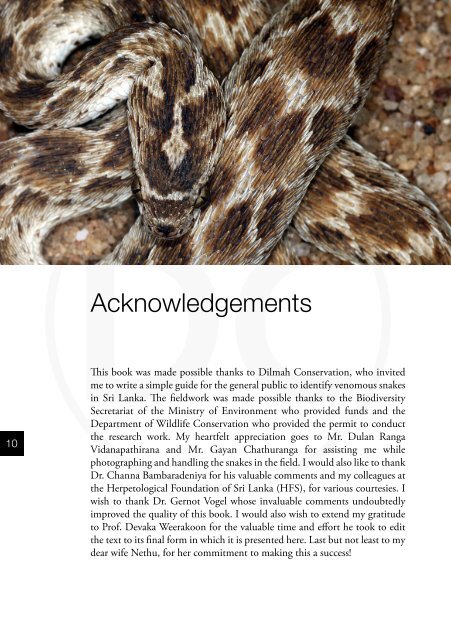Recognizing Deadly Venomous Snakes from Harmless Snakes of Sri Lanka
Recognizing Deadly Venomous Snakes from Harmless Snakes of Sri Lanka
Recognizing Deadly Venomous Snakes from Harmless Snakes of Sri Lanka
Create successful ePaper yourself
Turn your PDF publications into a flip-book with our unique Google optimized e-Paper software.
Contents<br />
10<br />
Acknowledgements<br />
This book was made possible thanks to Dilmah Conservation, who invited<br />
me to write a simple guide for the general public to identify venomous snakes<br />
in <strong>Sri</strong> <strong>Lanka</strong>. The fieldwork was made possible thanks to the Biodiversity<br />
Secretariat <strong>of</strong> the Ministry <strong>of</strong> Environment who provided funds and the<br />
Department <strong>of</strong> Wildlife Conservation who provided the permit to conduct<br />
the research work. My heartfelt appreciation goes to Mr. Dulan Ranga<br />
Vidanapathirana and Mr. Gayan Chathuranga for assisting me while<br />
photographing and handling the snakes in the field. I would also like to thank<br />
Dr. Channa Bambaradeniya for his valuable comments and my colleagues at<br />
the Herpetological Foundation <strong>of</strong> <strong>Sri</strong> <strong>Lanka</strong> (HFS), for various courtesies. I<br />
wish to thank Dr. Gernot Vogel whose invaluable comments undoubtedly<br />
improved the quality <strong>of</strong> this book. I would also wish to extend my gratitude<br />
to Pr<strong>of</strong>. Devaka Weerakoon for the valuable time and effort he took to edit<br />
the text to its final form in which it is presented here. Last but not least to my<br />
dear wife Nethu, for her commitment to making this a success!<br />
Foreword .................................................................................................... 8<br />
Preface ........................................................................................................ 9<br />
Acknowledgements ..................................................................................... 10<br />
1. <strong>Snakes</strong> <strong>of</strong> <strong>Sri</strong> <strong>Lanka</strong> ..................................................................................... 12<br />
1.1 Snake bites in <strong>Sri</strong> <strong>Lanka</strong> ....................................................................... 16<br />
2. What is a Snake? ........................................................................................ 17<br />
3. Identification <strong>of</strong> <strong>Venomous</strong> snakes ............................................................... 20<br />
3.1 Mimicry ........................................................................................... 20<br />
4. Kraits .......................................................................................................... 24<br />
4.1 Bungarus caeruleus (Thel karawala/ Indian krait) ................................. 26<br />
4.2 Non venomous species that mimic the Indian Krait ............................... 28<br />
4.2.1 Lycodon aulicus (Alu radanakaya/ Wolf snake, House snake) .............. 28<br />
4.2.2 Lycodon osmanhilli (Mal radanakaya/ Flowery wolf snake) ................. 30<br />
4.2.3 Lycodon striatus (Kabara radanakaya/ Shaw’s wolf snake) ................... 31<br />
4.3 Bungarus ceylonicus (Mudu karawala/ <strong>Sri</strong> <strong>Lanka</strong>n krait) ...................... 33<br />
4.4 Non venomous species that mimic the <strong>Sri</strong> <strong>Lanka</strong>n Krait ...................... 35<br />
4.4.1 Cercaspis carinata (Dhara radanakaya/ <strong>Sri</strong> <strong>Lanka</strong> wolf snake) ............. 35<br />
4.4.2 Dryocalamus nympha (Geta radanakaya, Geta karawala/ Bridal snake) 37<br />
4.4.3 Dryocalamus gracilis (Meegata radanakaya/ Scarce bridal snake) ......... 38<br />
5. Vipers ........................................................................................................ 39<br />
5.1 Daboia russelii (Thith polanga/ Russell’s viper) ..................................... 40<br />
5.2 Non venomous species that mimic the Russell’s viper ............................ 42<br />
5.2.1 Eryx conicus (Wali pimbura, Kota pimbura / Sand boa) ..................... 42<br />
5.2.2 Python molurus (Dara pimbura, Ran pimbura/ Rock python) ........... 44<br />
5.3. Echis carinatus (Wali polanga/ Saw scaled viper) .................................. 46<br />
5.4. Non venomous species that mimic the Saw scaled viper ......................... 48<br />
5.4.1 Boiga triginata (Garandi mapila, Ran mapila, .................................. 48<br />
Kaeta mapila/ Gamma cat snake)<br />
6. Cobra ......................................................................................................... 50<br />
6.1 Naja naja (Naya or Nagaya/ Indian cobra, Spectacled cobra) ................ 50<br />
Literature cited ................................................................................................. 53















